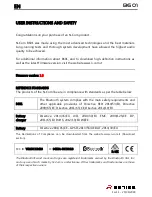
8
PART II: INITIALIZATION
This step only applies to a mount with Auto-homing feature (such as the Sky-Watcher EQ8
Equatorial mount).
• The LCD screen will display “
Auto-Home?
” in the first line, and display “
1) YES 2) NO
”
in the second line.
• Press “
2
” to skip this step and proceed to the next step.
• Press “
1
” to start the auto-homing routine on the mount. Once complete, the screen will
display “
Home Position Established
”. Press
ENTER
to proceed to the next step.
• During auto-homing routine, pressing the
ESC
key will stop the mount’s movement. The
screen will display “
Home Position NOT Established
.” Press
ENTER
to proceed to the next
step.
• After the home position is established, the LCD screen will display “
Add DEC offset?
” in
the
first line, and display “
1)YES 2)NO
” in the second line.
• Press “
2
” to skip this step and proceed to the next step.
• Press “
1
” and then use the numeric keys and the
LEFT/RIGHT
directional keys to enter
offset (in degree) of the declination axis and then press
ENTER
key to confirm. The decli
-
nation axis will start slewing to the designated offset position. This function is designed
for side-by-side dual telescopes setup.
Geographic Coordinates
The LCD screen will display “
Enter Location
” in the first line, and display longitude and
lat-
itude in the second line.
•
Press the numeric keys at the cursor position to fill the longitude and latitude digits.
• Use the scroll keys to change east/west longitude or north/south latitude when the cur-
sor blinks on the corresponding characters (
E/W
for longitude,
N/S
for latitude).
• Use the
Left
and
Right
direction keys to move the cursor.
• Press the
ENTER
key to confirm the input and proceed to the next step.
• Press the
ESC
key to return to Step 4 or Step 3.
4.
Auto-homing
5.
Setting Information of the Observing Site
Time Zone
The LCD screen will display “
Set Time Zone
” in the first line, and display the current time
zone in the second line.
• Use the scroll keys to change the leading “
+
” or “
-
” sign when the cursor is on it. The “
+
”
sign is used for time zones in the Eastern Hemisphere (Europe, Africa, Asia, Oceania),
while the “
-
” sign is used for time zones in the Western Hemisphere (North and South
America).
•
Press the numeric keys at the cursor position to fill the time zone digits.
• Press the
ENTER
key to confirm the input and proceed to the next step.
• Press the
ESC
key to return to the previous step.









































